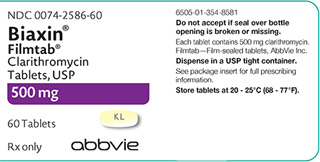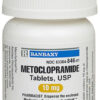Medication Overview: Biaxin
Biaxin, generically known as clarithromycin, is a macrolide antibiotic used to treat a variety of bacterial infections. It is particularly effective against respiratory tract infections, skin infections, and Helicobacter pylori-related conditions. Biaxin works by inhibiting bacterial protein synthesis, thereby preventing bacterial growth and multiplication.
Pharmacological Properties
Clarithromycin, the active ingredient in Biaxin, is a semi-synthetic derivative of erythromycin. It binds to the 50S ribosomal subunit of susceptible bacteria, leading to an inhibition of protein synthesis. Biaxin exhibits bacteriostatic activity, although at higher concentrations, it may exhibit bactericidal action. It is well absorbed orally and has good tissue penetration, ensuring effective concentration at sites of infection.
Available Formulations
Biaxin is available in various forms, including immediate-release tablets, extended-release tablets, and oral suspension. Immediate-release tablets are typically administered twice daily, while extended-release tablets are designed for once-daily dosing. The oral suspension is useful for patients who have difficulty swallowing tablets, such as children or the elderly. The choice of formulation may depend on the severity of the condition and patient preferences.
Approved Indications
Biaxin is prescribed for several bacterial infections including, but not limited to, community-acquired pneumonia, acute bacterial sinusitis, and chronic bronchitis in adults. It is also indicated for the treatment of streptococcal pharyngitis and skin and skin structure infections. Additionally, Biaxin forms part of combination therapy for the eradication of Helicobacter pylori to reduce the risk of duodenal ulcer recurrence.
Dosage and Administration
The usual adult dose for most infections is 250 mg to 500 mg every 12 hours for 7 to 14 days, depending on the severity and type of infection. Extended-release tablets are typically administered at a dose of 1000 mg once daily. For pediatric patients, the dosing is usually based on body weight, and the oral suspension is typically used. It is vital to complete the full course to prevent bacterial resistance.
Pharmacokinetics and Metabolism
The absorption of clarithromycin is rapid, with peak plasma concentrations reached within 2 to 3 hours after ingestion of the immediate-release tablet. The bioavailability of Biaxin is approximately 50%, with hepatic metabolism producing an active metabolite, 14-hydroxy clarithromycin. The elimination half-life varies between 3 to 4 hours for the parent drug and 5 to 7 hours for its metabolite, facilitating twice-daily dosing for most formulations.
Drug Interactions
Biaxin may interact with various medications, notably those metabolized by the liver’s cytochrome P450 system. Drugs such as warfarin, colchicine, and statins may experience altered plasma concentrations when co-administered with Biaxin. Clinicians should closely monitor for signs of toxicity or decreased efficacy when prescribing Biaxin alongside such medications. Dose adjustments might be necessary to manage interactions effectively.
Impact on Clinical Laboratory Tests
Biaxin can interfere with certain laboratory tests, potentially leading to false results. It may cause elevations in liver transaminases, often indicating hepatic stress or impairment. Additionally, interactions have been noted with serum creatinine and glucose levels tests. Health professionals should be cognizant of these potential interferences, especially when evaluating diagnostic test outcomes in patients undergoing Biaxin therapy.
Effects on Special Populations
Patients with renal impairment may require dosage adjustments due to altered pharmacokinetics. In severe hepatic dysfunction, Biaxin usage should be cautious and closely monitored due to potential accumulation. Elderly patients often experience increased systemic exposure, necessitating vigilance for adverse reactions. Pregnant and lactating women should use Biaxin only if clearly needed, considering potential risks versus benefits.
Resistance Mechanisms
Bacterial resistance to Biaxin arises through several mechanisms, including the modification of ribosomal targets preventing antibiotic binding, efflux pumps that remove the antibiotic from bacterial cells, and enzymatic degradation of the drug. Such resistance may compromise the efficacy of Biaxin, necessitating alternative antibiotic choices or combination therapies to effectively manage infections.
Clinical Efficacy Studies
Numerous clinical trials have validated Biaxin’s efficacy in treating susceptible bacterial infections. Research demonstrates high cure rates in community-acquired pneumonia and a significant reduction in Helicobacter pylori infection when used in triple therapy. Comparative studies with other macrolides reveal similar efficacy profiles but with a distinct advantage in terms of reduced gastrointestinal side effects.
Excretion and Elimination
Biaxin is primarily excreted via the kidneys, with roughly 20% to 40% of the administered dose excreted unchanged in the urine. The rest is eliminated as metabolites. Significant renal impairment affects drug clearance, necessitating dose adjustments. Minimal amounts are excreted in feces, showcasing the drug’s extensive metabolism and renal excretion pathways.
Stability and Storage
Biaxin immediate-release and extended-release tablets should be stored at room temperature, away from moisture and light. The oral suspension should be stored at controlled room temperature but not refrigerated, and kept tightly closed when not in use. Proper storage conditions are imperative for maintaining the medication’s efficacy and safety over its shelf life.
Adverse Reaction Profile
Common adverse reactions to Biaxin include gastrointestinal disturbances such as nausea, diarrhea, and dyspepsia. Some patients may experience taste alterations, headache, or rash. Rarely, more severe effects such as hepatotoxicity and cardiac arrhythmias, including QT prolongation, have been reported. Monitoring for adverse reactions is critical for optimizing treatment outcomes.







Reviews
There are no reviews yet.